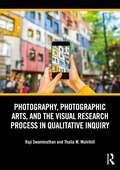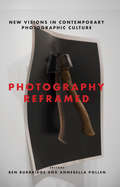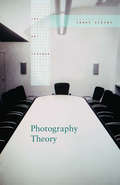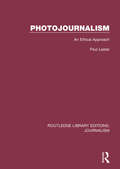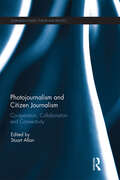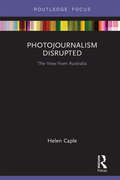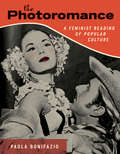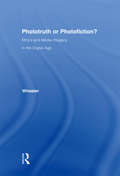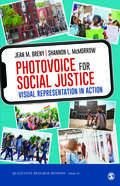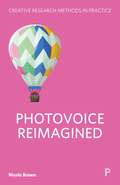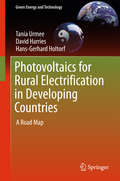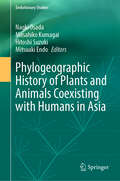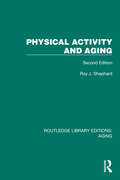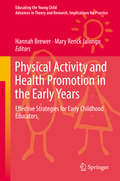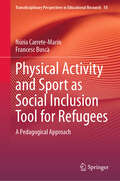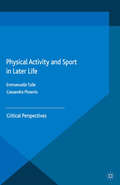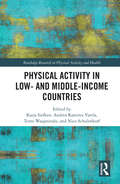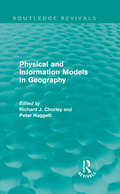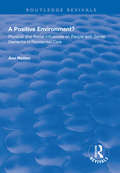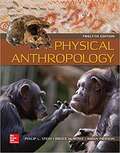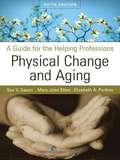- Table View
- List View
Photography, Photographic Arts, and the Visual Research Process in Qualitative Inquiry
by Raji Swaminathan Thalia M. MulvihillPhotography, Photographic Arts and the Visual Research Process in Qualitative Inquiry is a book that introduces doctoral students and early career researchers to photography as a significant dimension of visual qualitative methods.It examines the potential of photographic arts in qualitative research by highlighting theory and practice. Theories of photographic research and the types of photography within the genre are presented along with tips and exercises on how to conduct visual research through the use of photography. The central features of this book include learning to incorporate photography and photographic thinking through the arc of the research process. Question posing, data gathering, data analysis, and presentation and dissemination of photographic research ae discussed. Ethics for photographic qualitative research is discussed. Learning to consider all senses for visual analysis and to consider issues of power and equity in photographic research is explained. Readers of this book can practice different ways to think about photographic research through the exercises and tips offered at the end of each chapter.Graduate students and early career researchers who are interested in qualitative research will find this book valuable to learn and experiment with photography and photographic arts in visual qualitative research.
Photography Reframed: New Visions in Contemporary Photographic Culture (International Library Of Visual Culture Ser.)
by Ben BurbridgeAt a critical point in the development of photography, this book offers an engaging, detailed and far-reaching examination of the key issues that are defining contemporary photographic culture. Photography Reframed addresses the impact of radical technological, social and political change across a diverse set of photographic territories: the ontology of photography; the impact of mass photographic practice; the public display of intimate life; the current state of documentary, and the political possibilities of photographic culture. These lively, accessible essays by some of the best writers in photography together go deep into the most up-to-date frameworks for analysing and understanding photographic culture and shedding light on its histories. Photography Reframed is a vital road map for anyone interested in what photography has been, what it has become, and where it is going.
Photography: Theoretical Snapshots
by J. J. Long Andrea Noble Edward WelchOver the past twenty-five years, photography has moved to centre-stage in the study of visual culture and has established itself in numerous disciplines. This trend has brought with it a diversification in approaches to the study of the photographic image. Photography: Theoretical Snapshots offers exciting perspectives on photography theory today from some of the world’s leading critics and theorists. It introduces new means of looking at photographs, with topics including: a community-based understanding of Spencer Tunick’s controversial installations the tactile and auditory dimensions of photographic viewing snapshot photography the use of photography in human rights discourse. Photography: Theoretical Snapshots also addresses the question of photography history, revisiting the work of some of the most influential theorists such as Roland Barthes, Walter Benjamin, and the October group, re-evaluating the neglected genre of the carte-de-visite photograph, and addressing photography’s wider role within the ideologies of modernity. The collection opens with an introduction by the editors, analyzing the trajectory of photography studies and theory over the past three decades and the ways in which the discipline has been constituted. Ranging from the most personal to the most dehumanized uses of photography, from the nineteenth century to the present day, from Latin America to Northern Europe, Photography: Theoretical Snapshots will be of value to all those interested in photography, visual culture, and cultural history.
Photography Theory (The Art Seminar)
by Jame ElkinsPhotography Theory presents forty of the world's most active art historians and theorists, including Victor Burgin, Joel Snyder, Rosalind Krauss, Alan Trachtenberg, Geoffrey Batchen, Carol Squiers, Margaret Iversen and Abigail Solomon-Godeau in animated debate on the nature of photography. Photography has been around for nearly two centuries, but we are no closer to understanding what it is. For some people, a photograph is an optically accurate impression of the world, for others, it is mainly a way of remembering people and places. Some view it as a sign of bourgeois life, a kind of addiction of the middle class, whilst others see it as a troublesome interloper that has confused people's ideas of reality and fine art to the point that they have difficulty even defining what a photograph is. For some, the whole question of finding photography's nature is itself misguided from the beginning. This provocative second volume in the Routledge The Art Seminar series presents not one but many answers to the question what makes a photograph a photograph?
Photojournalism: An Ethical Approach (Routledge Library Editions: Journalism)
by Paul Martin LesterOriginally published in 1991. "A photojournalist is a mixture of a cool, detached professional and a sensitive, involved citizen. The taking of pictures is much more than F-stops and shutter speeds. The printing of pictures is much more than chemical temperatures and contrast grades. The publishing of pictures is much more than cropping and size decisions. A photojournalist must always be aware that the technical aspects of the photographic process are not the primary concerns." <P><P>This book addresses ethics in photojournalism in depth, with sections on the philosophy in the discipline, on pictures of victims or disaster scenes, on privacy rights and on altering images. As important and interesting today as when it was first in print.
Photojournalism and Citizen Journalism: Co-operation, Collaboration and Connectivity (ISSN)
by Stuart AllanIf everyone with a smartphone can be a citizen photojournalist, who needs professional photojournalism? This rather flippant question cuts to the heart of a set of pressing issues, where an array of impassioned voices may be heard in vigorous debate. While some of these voices are confidently predicting photojournalism's impending demise as the latest casualty of internet-driven convergence, others are heralding its dramatic rebirth, pointing to the democratisation of what was once the exclusive domain of the professional.Regardless of where one is situated in relation to these stark polarities, however, it is readily apparent that photojournalism is being decisively transformed across shifting, uneven conditions for civic participation in ways that raise important questions for journalism’s forms and practices in a digital era. This book's contributors identify and critique a range of factors currently recasting photojournalism's professional ethos, devoting particular attention to the challenges posed by the rise of citizen journalism. This book was originally published as two special issues, in Digital Journalism and Journalism Practice.
Photojournalism Disrupted: The View from Australia (Disruptions)
by Helen CaplePhotojournalism Disrupted addresses the unprecedented disruptions in photojournalism over the last decade, with a particular focus on the Australian news media context. Using a mixed methods approach, the book assesses the situation facing press photographers and their employers in the supply of professional imagery for news storytelling. Detailed qualitative case studies looking at special events and crisis reporting complement a longitudinal study of sourcing practices around everyday events. Additionally, interviews with industry professionals offer insights into how news organizations are managing significant structural change. Ultimately, the book argues that photojournalism is being reshaped in line with wider industrial disruptions that have led to the emergence of a highly casualized workforce. As a comprehensive study of contemporary photojournalism practices, Photojournalism Disrupted is ideal for scholars and students internationally, as well as (photo)journalists and media professionals.
The Photoromance: A Feminist Reading of Popular Culture
by Paola BonifazioA fascinating feminist reading of an often scorned medium: the storytelling, cross-platform success, and female fandom of the photoromance.Born in Italy and successfully exported to the rest of the world, photoromances had a readership of millions in the postwar years. By the early 1960s, more than ten million Italians read a photoromance each week. Despite its popularity, the photoromance--a form of graphic storytelling that uses photographs instead of drawings--was widely scorned as a medium, and its largely female audience derided as naive, pathetic, and uneducated. In this provocative book, Paola Bonifazio offers another perspective, making a case for the relevance of the photoromance for both feminism and media culture. She argues that the photoromance pioneered storytelling across platforms, elevated characters and artists into brands, and nurtured a devoted fan base. Moreover, Bonifazio shows that female readers--condescended to by intellectuals, journalists, and politicians of both the left and the right--powered the Italian photoromance industry's success.
Phototruth Or Photofiction?: Ethics and Media Imagery in the Digital Age
by Thomas H. WheelerThis text examines the use of images in journalistic contexts and the manipulation of these images to accomplish varying objectives. It provides a framework for critical discussion among professionals, educators, students, and concerned consumers of newspapers, magazines, online journals, and other nonfiction media. It also offers a method of assessing the ethics of mass-media photos, which will help visual journalists to embrace new technologies while preserving their credibility. Phototruth or Photofiction? also: *recounts the invention of photography and how it came to be accorded an extraordinary degree of trust; *details how photos were staged, painted, composited and otherwise faked, long before digital technology; *lists contemporary image-altering products and practices; *details many examples of manipulated images in nonfiction media and lists rationales offered in defense of them; *explains how current ethical principles have been derived; *lays groundwork for an ethical protocol by explaining conventions of taking, processing, and publishing journalistic photos; and *offers tests for assessing the appropriateness of altered images in non-fiction media. Each chapter is followed by "Explorations" designed to facilitate classroom discussion and to integrate into those interactions the students' own perceptions and experiences. The book is intended for students and others interested in the manipulation of images.
Photovoice for Social Justice: Visual Representation in Action (Qualitative Research Methods)
by Jean M. Breny Shannon L. McMorrowPhotovoice for Social Justice, the latest volume in SAGE′s Qualitative Research Methods Series, helps readers in the health and social sciences learn the foundations and applications of this exciting qualitative method. Authors Jean M. Breny and Shannon L. McMorrow approach photovoice as not only a community-based participatory research method, but as a method for social justice, centering community participants, organizations, and policy makers at the heart of this research method. Special topics relating to social justice include a focus on ethics and working with marginalized communities, sensitive concerns during data collection, and presenting the work to communities and policymakers, as well as academics. Written for students and researchers new to photovoice, this brief text takes readers from the process of conceptualizing and implementing a photovoice study to analyzing data and finally presenting the results of the study. The book concludes with suggestions for future iterations of photovoice, including web based resources and digital storytelling. The authors take into account the realities of photovoice as a method by providing practical, applied tools including sample consent forms, presentations, recruitment flyers, and photo-taking tips. Using Photovoice for Social Justice, new and experienced researchers can design, implement, and analyze their photovoice projects.
Photovoice for Social Justice: Visual Representation in Action (Qualitative Research Methods)
by Jean M. Breny Shannon L. McMorrowPhotovoice for Social Justice, the latest volume in SAGE′s Qualitative Research Methods Series, helps readers in the health and social sciences learn the foundations and applications of this exciting qualitative method. Authors Jean M. Breny and Shannon L. McMorrow approach photovoice as not only a community-based participatory research method, but as a method for social justice, centering community participants, organizations, and policy makers at the heart of this research method. Special topics relating to social justice include a focus on ethics and working with marginalized communities, sensitive concerns during data collection, and presenting the work to communities and policymakers, as well as academics. Written for students and researchers new to photovoice, this brief text takes readers from the process of conceptualizing and implementing a photovoice study to analyzing data and finally presenting the results of the study. The book concludes with suggestions for future iterations of photovoice, including web based resources and digital storytelling. The authors take into account the realities of photovoice as a method by providing practical, applied tools including sample consent forms, presentations, recruitment flyers, and photo-taking tips. Using Photovoice for Social Justice, new and experienced researchers can design, implement, and analyze their photovoice projects.
Photovoice Handbook for Social Workers: Method, Practicalities and Possibilities for Social Change
by Michele JarldornThis book provides inspiration for social workers to explore the possibilities of using Photovoice to engage with communities. Built on strong theoretical foundations and grounded in ethical principles, Jarldorn assesses Photovoice as an arts-based approach that provides a valuable mechanism for social workers to engage people in participatory action research, with the potential to influence policy and public opinion. Positioning Photovoice as a method aligned with feminist and radical social work perspectives, the author draws upon her research project which used Photovoice with former prisoners to demonstrate the transformative potential of participatory methods. Photovoice Handbook for Social Workers is intended to be a useful, hands-on resource, combining the importance of theory and the practicalities of doing action research.
Photovoice Reimagined (Creative Research Methods in Practice)
by Nicole BrownOver the past decades, ‘photovoice’ has emerged as a participatory and creative research method in which participants capture and discuss their reality through photographs. This indispensable ‘how-to’ book with exercises and visual aids takes novice and veteran researchers through the practicalities and ethics of applying this approach. Written by experienced teacher Nicole Brown, the book: - outlines the conceptual foundations and historical development of the approach; - redefines photovoice as a research method and as a framework; - explores how photovoice can be used in all stages of research from data collection to dissemination; - provides guidance and food for thought to get researchers started on their project. Each chapter ends with exercises that focus readers' learning and understanding by practically engaging them in the work presented throughout. The examples and visual aids will help them recognise all the details presented and represented in a photograph. For researchers who would like to try their hand at photovoice as a method or as a framework to foster a more participatory approach, this is the ultimate guide to kickstart their project.
Photovoltaics for Rural Electrification in Developing Countries
by Tania Urmee David Harries Hans-Gerhard HoltorfThe evidence suggests that many solar programs are being designed and implemented in isolation and without reliance on published guidelines or the experience gained by others. The conclusion is obvious: the likelihood of a program being successful would be greatly improved if program implementers were made more aware of best practice guidelines and of the lessons and experience learned by others in implementing previous programs. Furthermore, the best practice guidelines not only need to be readily available but need to describe the stages, issues and the stakeholders' roles in designing and implementing a SHS program. This book showcases a detailed road map that has been developed for the implementation of rural electrification projects in developing countries using solar PV. Features of this book will be case studies derived from personal participatory observation of the authors on Solar Home Systems, their impact, their advantages and disadvantages and their operation.
Phylogeographic History of Plants and Animals Coexisting with Humans in Asia (Evolutionary Studies)
by Naoki Osada Masahiko Kumagai Hitoshi Suzuki Mitsuaki EndoThis book offers a comprehensive understanding of the natural history of the Japanese Archipelago (Yaponesia), employing cutting-edge genomic research to provide insights into the prehistory in this region. It provides an in-depth exploration of the genetic makeup of domesticated plants and animals in the Japanese Archipelago, including their relationships with neighboring regions in Asia. The book is unique in its comprehensive approach, weaving together the latest genomic research, historical records, and linguistic analysis to provide a detailed understanding of the past. The book covers the development of Japanese society and culture from the Jomon era to the present day. It discusses the animal and plant diversity of the country, including their distribution, evolution, and interaction with human society and culture. The linguistic distributions of related terms are also explored. Using the latest genomic research, the book offers a fresh perspective on the past and present of the Japanese Archipelago, providing a comprehensive understanding of the natural and cultural history of the Japanese Archipelago. It is a valuable resource for professionals and academics in genomics, archaeology, and linguistics, as well as general readers interested in Japanese history, culture, and the environment.
Physical Activity and Aging: Second Edition (Routledge Library Editions: Aging)
by Roy ShephardIn the late 1980s, the relationship between physical activity or exercise and aging was one of great contemporary interest. On the one hand there was a growing elderly population in industrialized societies seeking an active rather than a passive retirement, while on the other hand there was much current interest in the benefits to health of physical activity.
Physical Activity and Health Promotion in the Early Years: Effective Strategies for Early Childhood Educators (Educating the Young Child #14)
by Hannah Brewer Mary Renck JalongoThis book focuses on improving well-being among young children. It provides a theoretical base explaining why physical activity is important, and offers practical strategies for increasing health and well-being in early childhood settings. It takes ancient wisdom on the mind and body connection, applies it to the youngest children, and supports it with current empirical and international evidence—all with an eye toward improving wellness across the lifespan. The many topics discussed in the book include children’s motor skills, movement, interaction, physical literacy, the use of video games, dog ownership, developmental delays, as well as strategies to improve physical activities in the classroom and broader contexts. In recent years, children’s health has become a priority worldwide. Topics such as “screen time” “sedentary behavior” and “childhood obesity” have become important issues everywhere- in the news, in schools, in community and commercials settings, and among health care providers. Limiting sedentary behavior, increasing physical activity, and maintaining a nutritious diet are three fundamental needs during early childhood. Preschool years are a time when children begin to explore the world around them, and develop more vivid understandings of their surroundings. As this book shows, the early years may be the best time to teach wellness concepts and assist young children in establishing healthy lifestyle habits.
Physical Activity and Sport as Social Inclusion Tool for Refugees: A Pedagogical Approach (Transdisciplinary Perspectives in Educational Research #10)
by Núria Carrete-Marín Francesc BuscàThis book addresses the social benefits of physical activity and sport in promoting the social and educational inclusion of refugees living in Europe in line with Sustainable Development Goals 4, 10 and 16. It provides a theoretical framework supported by evidence obtained from a case study in the Spanish context. The book demonstrates how universities and formal and non-formal educational institutions, by means of service-learning activities managed by physical and social educators, enable refugees and students to practice physical activity, develop further learning and establish stable social networks. It shows how a pedagogical approach to physical activity can improve relationships between students and refugees and promote inclusion of all. It discusses the value of diversity in education and educational research, as well as transdisciplinarity in new educational and research approaches.
Physical Activity and Sport in Later Life: Critical Perspectives (Global Culture and Sport Series)
by Emmanuelle Tulle Cassandra PhoenixThis volume addresses key issues such as the cultural and discursive context in which physical activity is discussed; the process of becoming physically active; the role of care settings in enabling physical activity; pleasure; gender; and place and space.
Physical Activity in Low- and Middle-Income Countries (Routledge Research in Physical Activity and Health)
by Nico Schulenkorf Katja Siefken Andrea Ramirez Varela Temo WaqanivaluThis book critically evaluates the complex relations between physical activity, health imperatives and cultural and social opportunities in low- and middle-income countries (LMICs). The book explores the uncertainty of knowledge around physical activity behavior and its distinctive meanings in LMIC contexts, the factors influencing physical activity, and how populations across the world understand and live the concept of physical activity. It discusses the key challenges and opportunities for sustaining physical activity within geographically and culturally diverse contexts of LMICs; introduces the reader to contemporary global physical activity approaches, models and policies; and presents case studies from around the world, including Asia, Africa, South America, the Pacific and Europe. Overall, the text relates theory to practical examples to facilitate a better understanding of physical activity in context, emphasizes the need for targeted, context-specific and locally relevant interventions to create PA-enabling environments in LMICs, and highlights the role of a range of stakeholders, including policy makers and urban planners, sport and recreation services, mass media, educators and the civil society in shaping population physical activity levels. Taken together, this edited volume brings together the latest research on PA in LMICs from around the world, informs and directs future research and necessary policy change towards the sustainable integration of PA opportunities, and seeks to ultimately foster and promote population-based PA in LMIC settings. By presenting empirical data and policy recommendations, this text will appeal to scholars, researchers and practitioners with an interest in physical activity research, public health, health promotion, sociology of sport, and sports sciences in LMICs, as well as policy makers and experts working in health promotion, public health, sports and fitness, but also in the urban planning and infrastructure and governmental industries.
Physical and Information Models in Geography (Routledge Revivals)
by Richard J. Chorley Peter HaggettFirst published in 1967, this book explores the theme of geographical generalization, or model building. It is composed of eight of the chapters from the original Models in Geography, published in 1967. The first chapter broadly outlines geographical generalization and examines the nature and function of generalized statements, ranging from conceptual models to scale models, in a geographical context. The following chapter deals with model theory in a wider scientific framework and the rest of the book discusses models of physical systems and information models. The book considers model-type generalizations that are applied in the three fields of geomorphology, meteorology and climatology, and hydrology before focusing on the transference of information and ideas in geography. This text represents a robustly anti-idiographic statement of modern work in one of the major branches of geography.
Physical and Social Influences on People with Senile Dementia in Residential Care: Physical and Social Influences on People with Senile Dementia in Residential Care (Routledge Revivals)
by Ann NettenPublished in 1993. The Increasing numbers of very elderly people in the population and the decreased use of long-stay hospitals are leading to pressure for services in the community for people with dementia. Residential care plays an important role in the care of such people, and developing new, innovative services and monitoring the quality of care in existing institutions are important policy issues. The book describes an investigation into the relationship between the residential care environment and the welfare of residents with senile dementia. Unlike many studies of residential care, the study included aspects of both the physical and social environment and examined the impact on residents over time. The study used some innovative approaches to assessing the impact of the environment of residents and the book describes a model using quantitative techniques to analyse outcomes for residents. The policy issues and provide pointers for specifying standards for the care of residents with senile dementia. The potential for innovative schemes building on the results of the study is discussed, and the concept of ‘informal care homes’ is introduced.
Physical and Symbolic Borders and Boundaries and How They Unfold in Space: An Inquiry on Making, Unmaking and Remaking Borders and Boundaries Across the World
by Basak Tanulku Simone PekelsmaThis book critically examines how borders and boundaries, physical and symbolic, unfold in different geographies and spaces. It aims to understand why they exist and how they are constructed, deconstructed, and reconstructed.The book explores why certain borders/boundaries persist while others are removed, and new ones are erected. It does not focus on one form of border, boundary or geographic location. It shifts its attention to different geographies, borders, and boundaries. It also focuses on intersections between them and how they complete each other. The book provides case studies from the past and present, allowing readers to connect subjects, periods, and geographies. The chapters address classical subjects such as nation-states and tackle novel questions such as ownership against access, that is, of urban infrastructures, COVID-19 and lockdowns, and the divides within digital worlds. The book benefits from visual essays that complement the theoretical and empirical chapters, showing the complexity of the phenomenon in a simple and effective way.The book will be of interest to academics, researchers, and students working in the fields of urban and rural studies, urban sociology, cities and communities, urban and regional planning, urban anthropology, political sciences and migration studies, human geography, cultural geography, urban anthropology, and visual arts.
Physical Anthropology
by Philip L. Stein Bruce M. Rowe Brian PiersonPhysical Anthropology, has been thoroughly revised and updated to reflect the latest analyses, fossil finds, and discoveries in the field of physical anthropology. <p><p>This full-color text examines human evolution and biology through photos, illustrations, and an exploration of insights gleaned from anthropologists. Students of this text will appreciate the dynamic relationship between humans and their environment over time and develop the skills they need to dispel the myths and misconceptions surrounding evolutionary theory.
Physical Change and Aging: A Guide for the Helping Professions (5th edition)
by Sue V. Saxon Mary Jean Etten Elizabeth A. PerkinsAlthough this book focuses primarily on physical changes and the common pathologies associated with aging, it also considers the psychological and social implications of such changes for human behavior. Since aging is a complex process, it is impossible to consider biological or physical aspects without a comparable concern for the psychological, emotional, and social factors involved.
